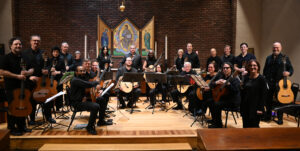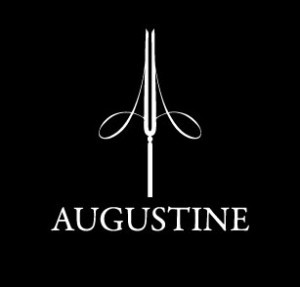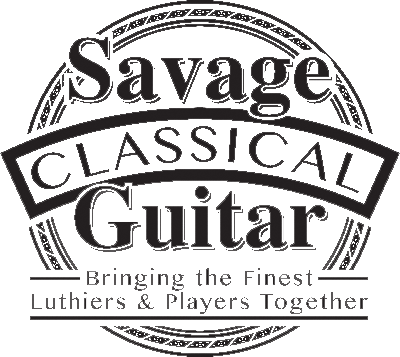By Gerry Saulter
January 2004
Christopher Parkening is ranked as one of the world’s preeminent virtuosos of the classical guitar. The Washington Post cited him as “the leading guitar virtuoso of our day combining profound musical insight with complete technical mastery of his instrument,” and the Los Angeles Times wrote, “Parkening is considered America’s reigning classical guitarist, carrying the torch of his mentor, the late Andrés Segovia.” The great Spanish guitarist Segovia proclaimed that “Christopher Parkening is a great artist — he is one of the most brilliant guitarists in the world.”
Christopher has performed around the world, including such prestigious places as Carnegie Hall and the White House. His television appearances include the Grammy Awards, The Tonight Show, The Today Show, Good Morning America, and 20/20. He has recorded 20 albums, and earned two Grammy nominations in the category of “Best Classical Recording.” He recently received the University Musical Society’s “Distinguished Artist Award” for 2003 at the Ford Honors Program. He founded the classical guitar department at Pepperdine University, and holds the Christopher Parkening Chair in Classical Guitar as Distinguished Professor of Music.
I had the pleasure of speaking with Mr. Parkening in late April of this year.
Welcome back to New York. I see that this concert features works of the modern era. What can you tell us about this program?
Well, the program title is “Masterworks of the 20th Century” and it is really my favorite works written for the classical guitar in the 20th century. It is a collection of music from around the world, consisting of works by composers such as Leo Brouwer, Astor Piazzolla, Alexandre Tansman, Carlo Domeniconi, Thomas Geoghegan, Stanley Myers, Andrew York, Heitor Villa-Lobos, Manuel Ponce, Joaquin Rodrigo, Federico Moreno Torroba, and Mario Castelnuovo-Tedesco.
I grew up in Los Angeles, and I had the privilege of meeting the wonderful composer Mario Castelnuovo-Tesdesco. I played his Concerto in D Major for Guitar and Orchestra (dedicated originally to Segovia) at my debut concert at Royce Hall at UCLA, when I was 15 years old. I remember seeing him weekly at his home in Beverley Hills. He (Castlenuovo-Tedesco) would play the orchestra part on piano while I played guitar. It was a wonderful and memorable experience. Through the years he would send me music. I premiered his Second Concerto in C Major for Guitar and Orchestra in Los Angeles, as well.
Will you consider recording this program?
I have three recordings planned with EMI. We are in the initial planning stages. I would consider all the music that I play on tour for recording at some point. I must reflect on something I learned from Segovia in regard to recording. He advised me years ago to take a piece of music on tour for at least a year before committing it to recording. His actual words were, “It is necessary to burnish a piece of music before recording it.” His feeling, and I agree, was that there is nothing that will refine a piece quite like performing it for some time.
In a sense, you “live” with a piece for a while.
Exactly. The piece matures, your knowledge of the music grows, and it becomes a part of you.
What inspires you when selecting works from the modern era?
That is a good question. It has to be a piece that moves my heart. I recall working with Elmer Bernstein on his Concerto for Guitar from my most recent CD. He had written the first movement, and he was about to start the second movement. He then said to me, “Christopher, I’m thinking of going in a bluesy direction. What do you think?” And my reply was, “That’s nice, but I would prefer a beautiful theme, a melody along the lines of what you wrote for the classic movie To Kill a Mockingbird.” And he said “Oh! You like a tune, do you?” I guess I’m a bit old fashioned that way.
Your last release for Angel/EMI featured that great new concerto by Elmer Bernstein. How closely did you work with him in arranging the guitar part?
I worked very closely with him. He lives here in LA, and we would get together in his studio in Santa Monica. We worked together weekly. We had the added help of Patrick Russ. He is a fine film orchestrator and an excellent guitarist. Elmer’s concern was that he didn’t really know the full potential of what the guitar could do. My reply to him was, “Elmer write it how you hear it, and we will make it work.” That relaxed him a bit. It made him feel at ease with the project. Many times he would write chords that were not in a standard guitar voicing, and this gave the music a wonderful quality, full of overtones that were not usual for the guitar. Some passages were difficult to play, but the sound was wonderful and new. Patrick Russ was indispensable in helping both of us in the development of this concerto.
Have you recently commissioned any other new works?
I have been in touch with the wonderful composer John Williams. I am hopeful that he will compose a concerto for guitar and orchestra. It is my belief that a John Williams concerto would be one of the great contributions to the classical guitar repertoire.
Have you ever considered trying some composing yourself?
Years ago when I attended USC I studied composition. In addition, I also studied composition with my cousin, Jack Marshall, but I never felt really talented in that area.
I have always believed that you can’t serve two masters, stylistically or compositionally.
That’s a good expression! I like that.
Do you have any news or festivals upcoming you would like to mention?
Yes. Thanks for asking. I recently accepted the position of Chair of Classical Guitar at Pepperdine University in Malibu, California. Pepperdine is the perfect fit for me in so many ways. Pepperdine hosted the Stotsenburg International Classical Guitar Competition in June, and later this summer, I will be giving my 29th annual summer masterclass at Montana State University. Your readers can log on to the web (parkening.com) for full details on all my upcoming events.
I wonder if you would give us your impressions on the “state of the classical guitar” in the modern era.
Well as you are well aware, I am a disciple of Andrés Segovia. He left a lasting impression upon me, and I have worked faithfully to carry on his tradition. However, in recent years there has been a growing trend away from this legacy of beauty, warmth and lyricism, in favor of a colder, mechanistic, and intellectual style of playing. In being dedicated to teaching, it is my goal to help reverse this trend. I am thankful that the leadership at Pepperdine University shares my views and believes that the pursuit of excellence in one’s art is a worthy endeavor.
What are your feelings about the “world composers” such as the late Astor Piazzolla who have written for the guitar?
That is another good question. You know, I recently went to a guitar department recital at a university and the entire program consisted of modern works. Most of the music was either atonal or “new age.” I thought to myself, “It is great that so many people are creating music for our instrument,” but what was missing for me in this recital was a sense of balance. There was no Bach, no Rodrigo, no Villa-Lobos, etc. I don’t want to forget the beautiful, warm, lyrical music of our glorious past, which was fundamental in bringing us to the present.
Are there any guitarists that you’ve been drawn to in recent years?
There are many fine technical players from all over the world, but few have a clear sense of artistic poetic phrasing with natural musicianship. Segovia would describe it as someone who plays with “artistic soul.” That’s what I’m listening for. I tell my students at Pepperdine to “sing the phrase.” The voice is the perfect instrument.
In teaching at the college level I find that all too often guitar students lock themselves into just guitar. In an effort to develop phrasing, I encourage students who may be working on a Bach selection to listen to how Jean Pierre-Rampal might have played it on flute or how Yo-Yo Ma would perform it on cello.
Good suggestion! It is so important for guitarists to become fine musicians. Artistic expression must be encouraged, and I am so glad to hear that you do that.
Are you still playing your Ramirez guitars?
Yes, I play two guitars primarily, both from the mid ’60s with cedar tops. I do have a couple of spruce-top Ramirez guitars from that period as well.
It has been said that in its construction, the guitar is less than perfect. Considering that so many luthiers are now working with new materials and construction bracing to increase the guitar sound output, have you experimented with any of them?
Yes, I have. As you tour and travel, you are always approached by luthiers. I am always interested in new guitars and keep an open mind. In some cases these guitars are extremely powerful. I consider that volume and power are only part of the deciding factor. For me there needs to be beauty, warmth and dynamic control. The ability to express myself is paramount. If someone shows me an instrument that meets my criteria, I’d be open to playing it. Until then, I’ll stick with my long-scale Ramirez guitars. Years ago, Jim Sherry in Chicago had many great Ramirez guitars to choose from, and the ones I have chosen have been with me a long time.
Thank you for you time.
It has been a pleasure. Have a wonderful evening.
Christopher Parkening will be playing at the 92nd St. Y on Jan 24, 2004. This article is reprinted from 20th Century Guitar Magazine by permission.









